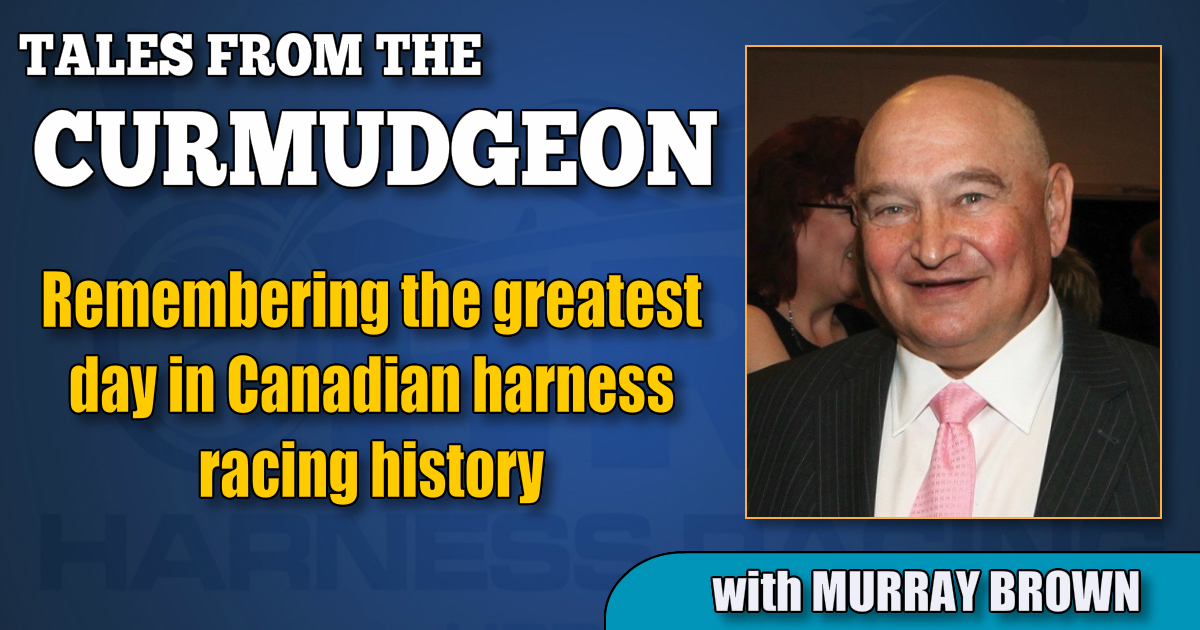Remembering the greatest day in Canadian harness racing history
Plus, the confounding case of offspring of Stars Pride and Hoot Mon.
by Murray Brown
After a lifetime in the sport, I’ve found that there are numerous questions to which I have no answers and to which I will never have answers. One of these concerns the great trotting stallion Stars Pride.
Stars Pride himself had bad feet. He was also known to pass this negative trait along to his offspring.
Hoot Mon, his stallion mate at Hanover Shoe Farms, also had bad feet. He was also known to pass these feet along to many of his sons and daughters.
Two questions that came to mind:
1. Why, knowing the tendency to produce horses with bad feet with both of them, were many Hoot Mon mares bred to Stars Pride?
2. Why did this same cross of Stars Pride on Hoot Mon mares produce three of the greatest horses that Stars Pride sired — Armbro Flight, Ayres and Nevele Pride?
I once wrote Jim Harrison and asked him these two questions. He responded that he would discuss it with me the next time we met.
Sadly, that day never came.
I believe the answer to number one can be answered in one word “geography”. The Hoot Mon mares were there, so they were booked to Stars Pride — quite simple.
The answer to question two is much more unknown. Why were they that good? To my knowledge, none of these three particular horses were known to have had trouble with their feet.
A possible answer might be in something I read after the passing of Bull Hancock, the patriarch of leading thoroughbred breeder Claiborne Farms.
One of Mr. Hancock’s theories regarding breeding was that perceived faults among great stallions were not necessarily faults at all. They were part of the horse’s genetic makeup. They were a small part of what contributed to his greatness.
Thus, for example, the tendency might be to breed a small stallion to large mares in hopes of reaching a happy medium. It doesn’t work that way, Mr. Hancock thought.
Being small was a big part of what made the horse great. Rather than breeding away from it, one should not necessarily breed that horse to small mares, but rather not to specifically breed away from an aspect of him that contributed to his greatness.
I’m not sure that I subscribe to it, but it’s an opinion and we all know what they say about opinions.
* * *
The name of Dick Baker recently surfaced in a Facebook conversation. To those who may not know, Mr. Baker, together with Aime Choquette, were perhaps the two best known second trainers in the history of our game. Dick Baker was best known as the second trainer and stable manager of the Stanley Dancer stable for many years. He also worked for Castleton Farms where he had similar duties. Aime did the same for Delvin Miller.
Let’s go to my first encounter with Dick Baker, a great man and a great horseman.
The date was Wednesday July 12, 1961. I was sitting in the last row of the Richelieu Park grandstand, which is where I usually sat while handicapping the evening’s racing card.
I was approached by a middle aged man who asked me if I spoke English. I obviously replied in the affirmative. He said “thank goodness.”
He identified himself as Dick Baker. I knew the name immediately. He said that he had been sent up there by his boss, Stanley Dancer, who had “loaned” him to Eddie Cobb.
Mr. Baker was to train Adios Butler the next morning because Eddie Cobb was racing in New York and couldn’t get away to do it himself.
Adios Butler was the favorite in that coming Sunday’s $25,000 invitational, the richest harness race to ever be held in Canada at the time.
Dick couldn’t speak a word of French and Richelieu was located in an almost all French speaking area on the extreme east of the island of Montreal.
He asked if we could go out for a bite later, so that I could translate the menu for him.
Thus began a lifelong friendship.
The next morning I was there bright and early so that I could see Dick training “The Butler”.
“He was great,” said Baker. “They won’t smell him on Sunday.”
Which brings me to the point of this story — the recounting of the greatest day in Canadian harness racing to that point in time, on July 16, 1961.
Before I go any further, I need to admit to some degree of plagiarism to both Robert Smith and to myself.
Robert wrote about that great day several years ago in his always interesting Saturday column on the Standardbred Canada website.
Much of what I’m writing is taken from that column and my response to it.
The rest of my week after watching The Butler train focused around this great race to be.
On a daily basis, I visited the stable where all the horses were domiciled. I distinctly remember Bye Bye Byrd’s stall having a huge sign saying DANGER, BEWARE!
Canadian harness racing’s greatest promotor ever, was the diminutive Georges Giguere, the racing secretary at Parc Richelieu.
Giguere had long dreamed of hosting a race at Richelieu which featured the greatest horses in North America.
However, in order to do it, he needed money — lots of it!
The purse that he envisioned needing to attract this caliber of horses was $25,000, an unheard of amount at the time.
In addition, he would need money to promote the race and an additional amount to pay for some of the expenses of the participants, both human and equine.
He went to the track’s owner Jean Louis Levesque with his proposal.
Mr. Levesque was known as a man who watched his dollars. The story is that he told Giguere that he would have to think about it.
According to rumors, Giguere went ahead with his plan before JLL had acquiesced to the proposal, knowing that his job would certainly be on the line if it failed.
On Sunday, I got to the track at around 10 a.m. By that time, the grandstand was already half full. By the time the first race went off, the track’s parking lots were totally full and people were parking as far as two miles away and walking to the track. Buses had been chartered from all over Eastern Canada to bring people to the event.
The race was to be televised live throughout Canada on the Canadian Broadcasting Corporation (CBC) network — a first for harness racing.
The official attendance was over 17,000, but that number did not account for the approximately 2,000 more watching it from the track’s backstretch and Hobert Soucie’s Hotel Richelieu.
Everything went perfectly. The weather and the race was ideal. As predicted by Dick Baker, Adios Butler won easily in a Canadian record shattering 1.58.2h.
Giguere played host to a cocktail party afterward for all the participants and their connections into to which I managed to sneak. Needless to say I was in awe.
Here’s the official finish of the race:
1. Adios Butler — Eddie Cobb
2. Bye Bye Byrd — Clint Hodgins
3. Apmat N — Billy Haughton
4. Tar Boy — Levi Harner
5. O’Brien Hanover — Delvin Miller.
6. Newport Admiral — Del Cameron
7. Sir Winston Pick — Roger White
ON A PERSONAL NOTE
Those who know me know how extraordinarily proud I am of both my children and my grandchildren — and how much I love them.
My two youngest kids, Andrew and Jennifer, attended and graduated from Philips Academy in Andover, MA, usually referred to as Andover.
It’s very coincidental that Alan Leavitt in his wonderful guest column on stallions in a recent HRU story (full story here) also mentioned Andover.
If Andover isn’t the finest prep school in North America, it is certainly in that small group in the conversation.
It is the oldest school of higher learning in the United States.
Its present student population includes kids from 52 countries and 43 states.
The quality of its alumni, including presidents, Medal of Honor winners, Supreme Court members, athletes, show business stars (Humphrey Bogart was expelled), artists, inventors and top business executives everywhere is probably without equal.
My daughter Jennifer told me last week that my youngest grandchild Jones was applying to Andover and that they had set up an interview for him.
That interview took place on Dec. 18.
I spoke with them afterwards.
They said they thought all went well and they hope that he gets in.
Jen had not been to the school for several years and was incredibly enthused about the way it had evolved since she had attended.
As great as it had been when she was there, she said it was at least five times (her description) even more impressive today.
Jonesie loved it, he said, and hoped so much that he gets in.
















